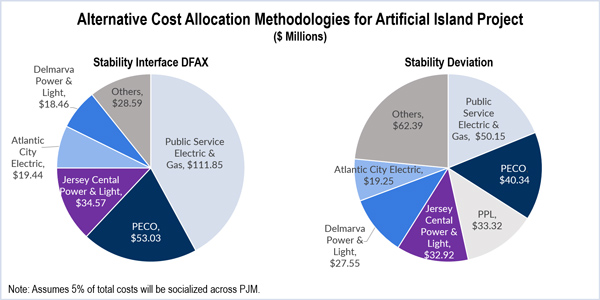By Rory D. Sweeney
Most of the $280 million bill for PJM’s Artificial Island project would shift from Delaware to New Jersey and Pennsylvania under two alternative analyses the grid operator developed in response to complaints about how costs for the project would be allocated.
PJM’s Board of Managers directed staff to develop the alternative analyses after ordering resumption of the project — PJM’s first under the FERC Order 1000 competitive bidding process — in April. (See Board Restarts Artificial Island Tx Project; Seeks Cost Allocation Fix.)
Steve Herling, PJM’s vice president of planning, presented the grid operator’s analyses on Friday but was careful to explain that the alternative cost allocations were meant to “facilitate discussion” and that PJM was not advocating for any specific method. The right to petition FERC for any changes under Section 205 of the Federal Power Act remains with the transmission owners, he said, but “we will support any discussion FERC would facilitate on this issue.”
The cost allocations under question will cover the majority of the cost of the project. PJM spokeswoman Paula DuPont said as much as 6.8% of the total will be socialized across the PJM footprint based on the project’s reliability value.
The current allocation method would saddle Delmarva Power & Light ratepayers with about 93% of the remaining bill. The first alternative, which Herling called a “direct extension” of the current solution-based distribution factor method, would reduce DPL’s responsibility to about 7% while raising the bill for Public Service Electric and Gas to more than 42%. New Jersey’s other utilities — Jersey Central Power & Light and Atlantic City Electric — would pick up 13% and 7.3%, respectively. PECO Energy would shoulder about 20% of the costs.
The second alternative, termed a “stability deviation method,” would allocate 19% to PSEG, 15% to PECO, 12.5% to PPL, 12.4% to JCPL, 10.4% to DPL, 7.2% to Atlantic City and about 5% to Met-Ed. Herling said the method was like dropping a rock in a pond and measuring impacts based on the ripples.
“Mathematically, you’re going to feel this disturbance all the way out to the Rocky Mountains,” he said, so PJM “arbitrarily” decided to ignore any load-bus deviations of less than 25%.
“Obviously, with the cutoff being arbitrary, it would give people some concerns,” he said. Additionally, the method would be “a lot more work for PJM,” he said, but he assured stakeholders that “it’s not something that we would shy away from.”
The failure of any of the methods will be its subjectivity, he said, and there are “any number of ways to tweak” the numbers.
“Let’s face it: advantages and disadvantages are in the eye of the beholder,” he said.
Documents and information about PJM’s conclusions were purposefully withheld until minutes before the Friday morning announcement, Herling said, because PJM wanted to be first to provide the information to its membership rather than have them learn of it through media reports.
The Delaware Public Service Commission was cheered by the new analyses, which it said “more appropriately reflect the benefits of a stability-based transmission solution.”
“Each of the alternate methods illustrate that Delaware customers benefit substantially less from the AI project than the previous solution-based DFAX cost allocation,” the PSC said in a statement.
“This is only a beginning step in a lengthy process to secure an appropriate cost allocation with results that are commensurate with the benefits to Delaware,” PSC Executive Director Robert Howatt said.




